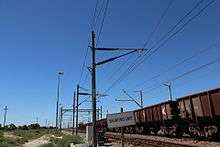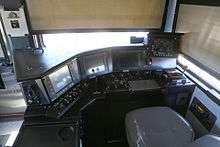Sishen–Saldanha railway line
| Ore Export Line | ||||||||||||||||||||||||||||||||||||||||||||||||||||||||||||||||||||||||||||||||||||||||||||||||||||||||||||||||||||||||||||||||||||||||||||||||||||||||||||||||||||||||||||||||||||||||||
|---|---|---|---|---|---|---|---|---|---|---|---|---|---|---|---|---|---|---|---|---|---|---|---|---|---|---|---|---|---|---|---|---|---|---|---|---|---|---|---|---|---|---|---|---|---|---|---|---|---|---|---|---|---|---|---|---|---|---|---|---|---|---|---|---|---|---|---|---|---|---|---|---|---|---|---|---|---|---|---|---|---|---|---|---|---|---|---|---|---|---|---|---|---|---|---|---|---|---|---|---|---|---|---|---|---|---|---|---|---|---|---|---|---|---|---|---|---|---|---|---|---|---|---|---|---|---|---|---|---|---|---|---|---|---|---|---|---|---|---|---|---|---|---|---|---|---|---|---|---|---|---|---|---|---|---|---|---|---|---|---|---|---|---|---|---|---|---|---|---|---|---|---|---|---|---|---|---|---|---|---|---|---|---|---|---|---|
| Overview | ||||||||||||||||||||||||||||||||||||||||||||||||||||||||||||||||||||||||||||||||||||||||||||||||||||||||||||||||||||||||||||||||||||||||||||||||||||||||||||||||||||||||||||||||||||||||||
| Type | Iron ore freight | |||||||||||||||||||||||||||||||||||||||||||||||||||||||||||||||||||||||||||||||||||||||||||||||||||||||||||||||||||||||||||||||||||||||||||||||||||||||||||||||||||||||||||||||||||||||||
| Locale | Western & Northern Cape, South Africa | |||||||||||||||||||||||||||||||||||||||||||||||||||||||||||||||||||||||||||||||||||||||||||||||||||||||||||||||||||||||||||||||||||||||||||||||||||||||||||||||||||||||||||||||||||||||||
| Termini |
Sishen, Northern Cape Saldanha, Western Cape | |||||||||||||||||||||||||||||||||||||||||||||||||||||||||||||||||||||||||||||||||||||||||||||||||||||||||||||||||||||||||||||||||||||||||||||||||||||||||||||||||||||||||||||||||||||||||
| Operation | ||||||||||||||||||||||||||||||||||||||||||||||||||||||||||||||||||||||||||||||||||||||||||||||||||||||||||||||||||||||||||||||||||||||||||||||||||||||||||||||||||||||||||||||||||||||||||
| Opened | 1976 | |||||||||||||||||||||||||||||||||||||||||||||||||||||||||||||||||||||||||||||||||||||||||||||||||||||||||||||||||||||||||||||||||||||||||||||||||||||||||||||||||||||||||||||||||||||||||
| Owner | Transnet Freight Rail | |||||||||||||||||||||||||||||||||||||||||||||||||||||||||||||||||||||||||||||||||||||||||||||||||||||||||||||||||||||||||||||||||||||||||||||||||||||||||||||||||||||||||||||||||||||||||
| Operator(s) | Transnet Freight Rail | |||||||||||||||||||||||||||||||||||||||||||||||||||||||||||||||||||||||||||||||||||||||||||||||||||||||||||||||||||||||||||||||||||||||||||||||||||||||||||||||||||||||||||||||||||||||||
| Depot(s) | Salkor Yard | |||||||||||||||||||||||||||||||||||||||||||||||||||||||||||||||||||||||||||||||||||||||||||||||||||||||||||||||||||||||||||||||||||||||||||||||||||||||||||||||||||||||||||||||||||||||||
| Technical | ||||||||||||||||||||||||||||||||||||||||||||||||||||||||||||||||||||||||||||||||||||||||||||||||||||||||||||||||||||||||||||||||||||||||||||||||||||||||||||||||||||||||||||||||||||||||||
| Line length | 861 km (535 mi) | |||||||||||||||||||||||||||||||||||||||||||||||||||||||||||||||||||||||||||||||||||||||||||||||||||||||||||||||||||||||||||||||||||||||||||||||||||||||||||||||||||||||||||||||||||||||||
| Track gauge | 1,067 mm (3 ft 6 in) | |||||||||||||||||||||||||||||||||||||||||||||||||||||||||||||||||||||||||||||||||||||||||||||||||||||||||||||||||||||||||||||||||||||||||||||||||||||||||||||||||||||||||||||||||||||||||
| Electrification | 50 kV AC overhead catenary | |||||||||||||||||||||||||||||||||||||||||||||||||||||||||||||||||||||||||||||||||||||||||||||||||||||||||||||||||||||||||||||||||||||||||||||||||||||||||||||||||||||||||||||||||||||||||
| Operating speed | 80 km/h | |||||||||||||||||||||||||||||||||||||||||||||||||||||||||||||||||||||||||||||||||||||||||||||||||||||||||||||||||||||||||||||||||||||||||||||||||||||||||||||||||||||||||||||||||||||||||
| ||||||||||||||||||||||||||||||||||||||||||||||||||||||||||||||||||||||||||||||||||||||||||||||||||||||||||||||||||||||||||||||||||||||||||||||||||||||||||||||||||||||||||||||||||||||||||
The Sishen–Saldanha railway line, also known as the Ore Export Line, is an 861 kilometres (535 mi) long heavy haul railway line in South Africa.[1] It connects iron ore mines near Sishen in the Northern Cape with the port at Saldanha Bay in the Western Cape.[1] It is used primarily to transport iron ore and does not carry passenger traffic.

The Sishen–Saldanha line was built by Iscor, the then iron and steel parastatal, opening in 1976.[2]
In 1977 the line was transferred to Transnet Freight Rail, then known as South African Railways & Harbours, and a decision was made to electrify the line.[2] A voltage of 50 kV AC was chosen instead of the usual 25 kV in order to haul heavier loads and to allow a larger distance between transformers.
A single-track line with ten crossing loops to allow trains travelling in opposite directions to pass was constructed; number of crossing loops has since increased to 19 in order to increase line capacity.[1]
From an altitude of 1,295 metres (4,249 ft) at Sishen, the line climbs for 42 kilometres (26 mi) before descending to cross the Orange River about 10 kilometres (6 mi) downstream of Groblershoop.[1] For the next 300 kilometres (190 mi), the line rises and falls before descending towards the Atlantic coast.[1] The railway crosses the Olifants River on a 1,035 metres (3,396 ft) viaduct between Vredendal and Lutzville[2] and reaches the coast about 160 kilometres (100 mi) north of Saldanha.[1] From there the line follows a coastal route.



Initial train lengths consisted of three class 9E electric locomotives, hauling 210 type CR ore wagons with a payload of 80 tons.[2] Upgraded wagons now carry 100 tons.[1] Train lengths have been increased to 342 wagons, employing Radio Distributed Power (RDP) technology. These trains have 8 locomotives and 342 wagons with a total mass of 41,400 tonnes and are 3,780 metres (12,400 ft) long, and they are the longest production trains in the world. More than 3,000 of these RDP trains have been operated since launched in December 2007.

See also
- South African Class 9E, Series 1
- South African Class 9E, Series 2
- South African Class 15E
- South African Class 34-000
- South African Class 34-400
- South African Class 34-500
- South African Class 34-900
- South African Class 43-000